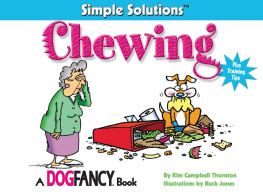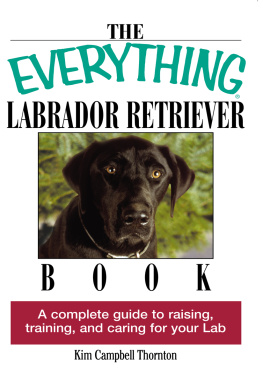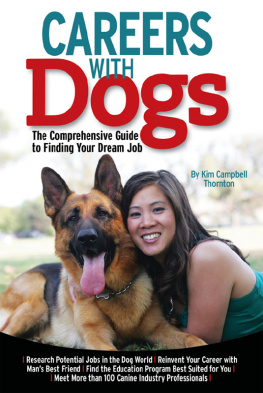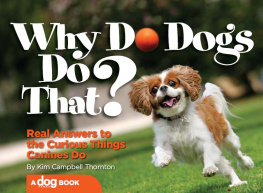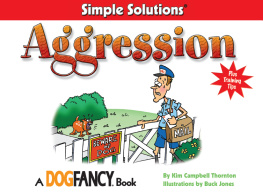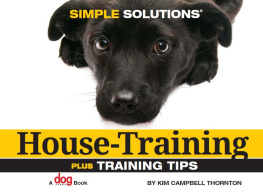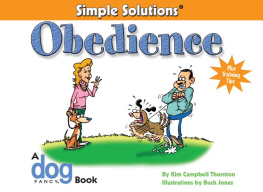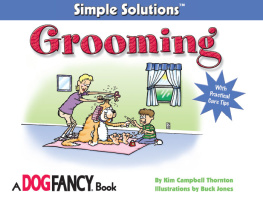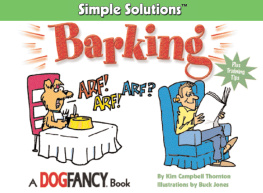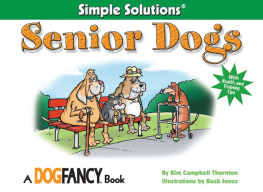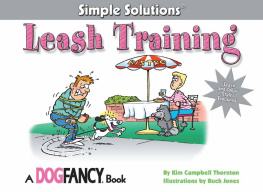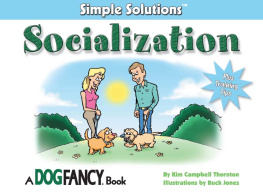Nick Clemente, Special Consultant
Amy Fox, Editor
Michael Vincent Capozzi, Designer
Copyright 2002 by I-5 Press
Illustrations copyright 2002 by Buck Jones
The dogs in this book are referred to as he and she in alternating chapters.
All rights reserved. No part of this book may be reproduced, stored in a retrieval system, or transmitted in any form or by any means, electronic, mechanical, photocopying, recording, or otherwise, without the prior written permission of I-5 Press, except for the inclusion of brief quotations in an acknowledged review.
Library of Congress Cataloging-in-Publication Data
Thornton, Kim Campbell.
Chewing / by Kim Campbell Thornton ; illustrations by Buck Jones.
p. cm. (Simple solutions)
ISBN 1-889540-82-X (pbk. : alk. paper)
eISBN: 9781620080658
1. DogsBehavior. 2. DogsTraining. 3. Mastication. I. Jones,
Buck. II. Dog fancy (San Juan Capistrano, Calif.) III. Title. IV. Series.
SF433 .T525 2001
636.7'0887dc21
2001004822
I-5 Press
A Division of I-5 Publishing, LLC
3 Burroughs
Irvine, California 92618
Printed and Bound in Singapore
10 9 8 7 6 5 4
Contents
Why Do Dogs Chew?
They gnaw on knickknacks, suck on socks, chew on chair legs. Their destructive power is roughly equivalent to that of a minor atomic weaponat least, thats the way it looks when you discover it. Stuffing pulled out of sofas, new designs nibbled into wallpaper, drywall exposed, wood floors destroyed. All this, while brand-new chew toys lie in the rubble, still pristine.
What causes dogs to chew and chew and chew? And how can you channel their chewing constructively?
Dogs chew for many reasons. Young dogs have a physiological need to chew. Chewing helps them to exercise and develop their jaws. Six-week-old puppies have a set of baby teeth (your veterinarian may refer to them as deciduous teeth). Through the process of teething, all the baby teeth will eventually be replaced by permanent teeth. Puppies start to lose their baby teeth when theyre six to seven months old, but permanent teeth dont fully come in until dogs are about one year old. During this time, puppies chew a lot. Chewing helps relieve the pain of teething and is a perfectly normal part of puppy growth and development. One solution to help relieve teething pain is to freeze an old wet washcloth and give it to your pup to chew on.


Puppies also go through an intense play period, and one of the things that puppies do in play is chew. Its fun to chew things up and see the pieces go flying!
Older dogs chew because its pleasurable or soothing for them. Chewing helps relieve boredom. It also helps keep dogs teeth and gums strong and healthy. Dogs with irritated or painful gums from gingivitis may chew excessively to help relieve the pain. Some dogs chew when theyre feeling nervous or stressed. Often, their chewing results from separation anxiety. In all these instances, chewing is a repetitive activity thats soothing and just plain feels good. Sort of like playing solitaire.

Of all the reasons dogs chew, spite isnt one of them. You may feel as if Max has destroyed your favorite pair of $200 sandals because you dont spend enough time with him, but face it, dogs just arent wired that way. While theyre pretty darn smart, they arent capable of thinking, Ill teach her to leave me alone for twelve hours straight. Ill go find her favorite, most expensive pair of shoes and eat them! The belief that dogs do things to get back at us is a myth that should have been retired long ago.
Now that you know why dogs chew, its time to examine your dogs chewing habits and your responses to them. Believe it or not, your dog can learn to chew just his toys, not yours. Teaching your dog whats okay to chew and whats not takes patience and consistency, but the savings in money and frustration are well worth the effort. And when your puppy is chewing on a toy, hes not barking, digging, or otherwise getting into trouble.
When Chewing Becomes a Problem
We often think that puppy chewing is cute. We might say, Look at her toss her head with that envelope in her mouth! We ignore this cute behavior until something valuable is destroyed, then we want to put a stop to it. By that time, however, the chewing of anything and everything is a habit thats difficult to break.
Preventing inappropriate chewing is not just good for your furniture and clothing but can save your dogs life. Dogs who chew electrical cords run the risk of death by electrocution. Dogs who steal garbage, cat food, or rich treats are at risk for pancreatitis, a potentially fatal inflammation of the pancreas. Dogs who eat socks, rocks, or childrens toys can suffer life-threatening intestinal blockages.


Destructive chewing is also harmful to your dog, as it frequently causes feelings of boredom, loneliness, and isolation. Dogs are intelligent, social animals who need the stimulation of activity and companionship. The psychological stress of being left alone on a regular basis can lead to phobias or anxieties that result in chewing as escape behavior (for instance, chewing through doors or windows) or chewing for relief (for example, when the dog is left alone or when a change occurs in the household, such as a new baby or a new work schedule).
Because chewing is so enjoyable and calming, dogs want to do it again and again. That desire to chew can become a good habit or a bad habit, depending on what dogs learn to chew and the quality of interaction they have with their owners.


If you have a puppy, youll need to start teaching her good habits in puppyhood. Given the opportunity, shes going to chew everything she can get her teeth on. Besides being entertaining, its simply her way of exploring her territory. When your puppy decides to chew on an electrical cord, its because she doesnt yet know that the cord isnt a toy like her hard rubber ball or bone. Teaching your puppy right chewing from wrong chewing requires a two-pronged approach: making your home safe for the puppy (and from the puppy) and redirecting improper chewing.
Dog-Proofing Your Home
Just like infants, puppies put anything and everything in their mouths. One veterinarian says he is astounded by the variety of things puppies will chew on or swallow. With that in mind, its a priority for new puppy owners or owners of chewers to take steps to remove temptations or make them unappealing or inaccessible. (The bonus to this is usually a neater, less-cluttered home.)
Smell is often what first attracts a dog to a forbidden item. Things that smell good to a dog range from stinky socks to leather shoes to ripe garbage. Make it a habit to put laundry in hampers, shoes in closed closets, and trash containers inside cabinets. If theres no room for the trash beneath the kitchen or bathroom sink, buy containers with locking lids. Avoid small decorative trash cans, which are just the right size for an inquisitive puppy to stick his nose into and pull out such shreddable treasures as envelopes and used tissues. Put small trash cans on top of your dresser or bathroom counter.
Next page
